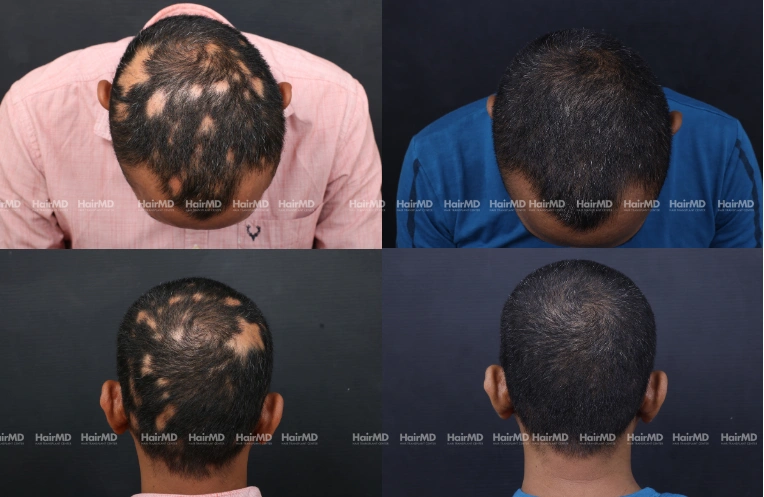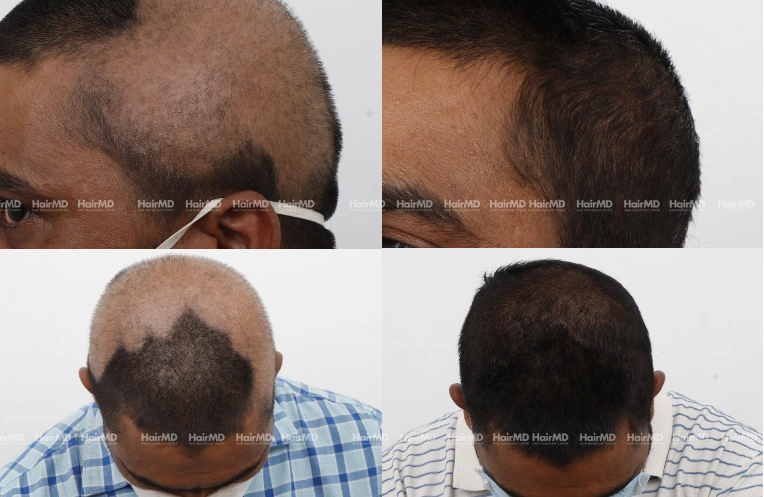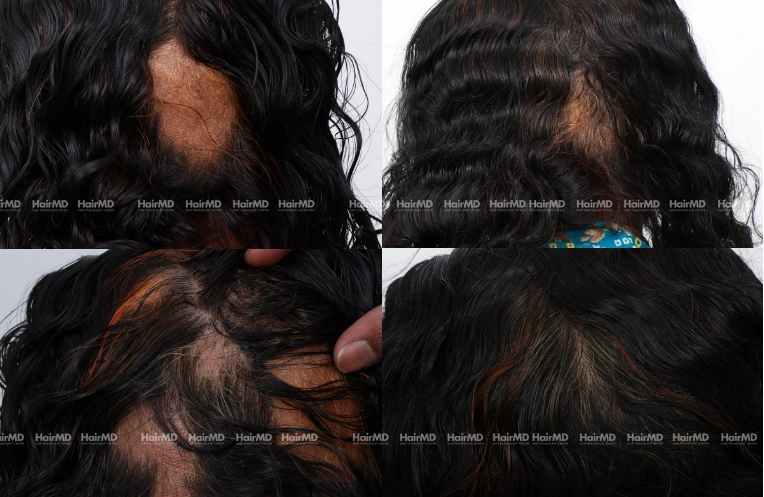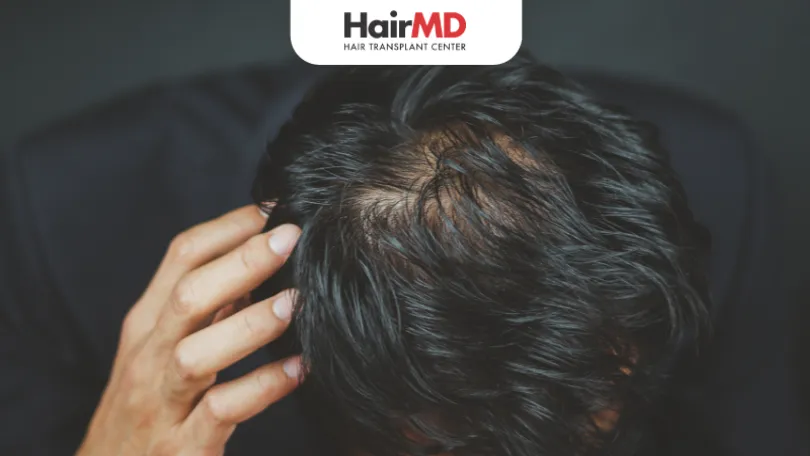What is Alopecia Areata?
Alopecia Areata is a sudden onset of hair loss in the head and sometimes all over the body in small scattered patches. This is caused when an auto-immune condition is triggered and the body starts attacking the hair follicle generating cells. In a few cases, the affected areas have seen total regrowth of hair without Alopecia Areata treatment.
| Downtime | Avg Cost Of Treatment | No. Of Sessions Required | Success Rate | No. Of Patients Treated |
|---|---|---|---|---|
| Max 5 Days | Depends On Treatment | 6-8 Sessions | 95% | 70,000+ |
Many Treatments. One Goal
Alopecia Areata Treatments. Stronger Hairs.

Conditions
Alopecia Areata
Treatment
Excimer Laser, Intralesional Steroid Injections, PRP, Low-Level Laser Light Therapy
Duration
6 Months, 7 Sessions (Settings)

Conditions
Alopecia Areata
Treatment
Excimer Laser, Intralesional Steroid Injections, PRP
Duration
6 Months, 7 Sessions (Settings)

Conditions
Alopecia Areata
Treatment
Excimer Laser, Intralesional Steroid Injections, PRP, Low-Level Laser Light Therapy
Duration
6 Months, 7 Sessions (Settings)
With Our Proprietary Treatment Approach, We Have Treated 1,47,000+ Patients Successfully.
Be one of them!
Educating & Empowering You
All You Need To Know About Alopecia Areata
Alopecia Areata occurs when the immune system mistakenly attacks hair follicles, leading to hair loss. This autoimmune response can be triggered by various factors, including genetic predisposition, environmental influences, and stress. In affected individuals, the immune system identifies hair follicles as foreign, resulting in inflammation and the interruption of normal hair growth cycles. Genetics play a significant role in Alopecia Areata, as individuals with a family history of autoimmune diseases are more likely to develop this condition. Specific genetic markers may predispose individuals to the disorder, increasing their vulnerability. Research indicates that certain genes involved in immune regulation and inflammation can contribute to the development of Alopecia Areata. Various environmental factors can trigger Alopecia Areata in genetically predisposed individuals. These triggers may include viral infections, severe stress, or exposure to toxins. Changes in the environment, such as significant life events, can also activate the immune response that leads to hair follicle damage. Identifying and managing these triggers can be crucial for preventing further hair loss.
Autoimmune Response

Genetic Factors

Environmental Triggers
Alopecia areata often presents as sudden, round patches of hair loss on the scalp or other areas. These bald patches can vary in size and may be completely smooth. The hair loss can occur over days or weeks, making it noticeable for individuals and potentially causing emotional distress. Early intervention can help manage the condition effectively. While Alopecia areata commonly affects the scalp, it can also lead to hair loss in other body parts, such as eyebrows, eyelashes, and facial hair. This widespread hair loss can significantly impact a person's appearance and self-esteem. Recognizing that alopecia areata can affect multiple areas is essential for comprehensive care and emotional support. Before the onset of hair loss, some individuals may experience itching or a tingling sensation in the affected areas of the scalp. This discomfort is often temporary and may subside once the hair begins to fall out. Understanding this symptom can help individuals identify the early stages of alopecia areata and seek appropriate treatment promptly.
Patchy Hair Loss

Hair Loss in Other Areas

Itching or Tingling Sensation
Intralesional steroid injections are commonly used to treat Alopecia Areata by delivering corticosteroids directly into the affected areas of the scalp. This helps reduce inflammation and suppress the immune response that targets hair follicles. Patients typically see improvement within a few weeks, with regrowth of hair in the treated regions. Regular sessions may be required for optimal results. Dermapen microneedling is a minimally invasive treatment that uses tiny needles to create micro-injuries in the scalp, promoting collagen production and enhancing blood flow. This technique helps deliver topical treatments more effectively and stimulates hair growth by activating the hair follicles. It's particularly useful for individuals with Alopecia Areata, as it encourages natural healing and hair regrowth over time. Platelet-Rich Plasma (PRP) therapy involves drawing a patient's blood, processing it to concentrate the platelets, and injecting it into the scalp. At HairMD Clinic, this treatment aims to stimulate hair follicles and promote regrowth in Alopecia Areata patients. PRP contains growth factors that enhance healing and hair growth, making it a promising option for restoring hair density.
Intralesional Steroid Injections

Dermapen Microneedling

Platelet-Rich Plasma (PRP) Therapy
Low-Level Laser Therapy utilizes specific wavelengths of light to stimulate hair follicles. This non-invasive treatment enhances blood flow, promoting cellular activity and potentially encouraging hair regrowth. LLLT is painless and can be used alongside other treatments for a synergistic effect. Regular sessions over weeks or months may help restore hair density in areas affected by Alopecia Areata. Diode Laser Therapy targets hair follicles with concentrated laser energy, which can stimulate hair growth by increasing blood circulation to the scalp. This treatment is effective in reducing inflammation and promoting the regeneration of hair follicles. Patients typically undergo a series of sessions, with noticeable results over time. It's a safe option for individuals experiencing hair loss due to Alopecia Areata. Fractional Laser Treatment involves using laser beams to create microscopic wounds in the scalp, promoting healing and encouraging hair growth. This method improves the scalp's overall health and can stimulate dormant hair follicles. The treatment is effective for both male and female patients with Alopecia Areata. Recovery is usually quick, with minimal side effects, making it a popular choice.
Low-Level Laser Therapy (LLLT)

Diode Laser Therapy

Fractional Laser Treatment
With over 35 years of experience in the field, HairMD Clinic has established itself as a trusted name in hair treatment, particularly for conditions like Alopecia Areata. Our long-standing presence in the industry speaks to our commitment to staying updated with the latest advancements in hair restoration. This extensive experience allows us to provide reliable solutions and expert guidance to our patients. HairMD Clinic embraces a holistic approach to treating Alopecia Areata, addressing not only the physical aspects of hair loss but also the emotional and psychological factors involved. We believe in treating the whole person, considering lifestyle, nutrition, and stress levels in our treatment plans. This comprehensive strategy enhances the effectiveness of our therapies, promoting overall well-being alongside hair restoration. Patient satisfaction is a top priority at HairMD Clinic. Our commitment to providing exceptional care and successful treatment outcomes for Alopecia Areata has resulted in high levels of patient satisfaction. We take pride in our personalized approach, attentive staff, and the effectiveness of our treatments. The positive feedback from our patients reflects our dedication to their well-being and hair restoration journey.
35+ Years of Experience

Holistic Approach

High Patient Satisfaction
HairMD India
HERE’S WHY WE’RE PUNE’S TOP CHOICE FOR ALOPECIA AREATA TREATMENTS!
HairMD Clinic is a premier center for Alopecia Areata treatment in Pune, recognized for its specialized expertise in hair loss solutions. The clinic offers tailored treatments that cater to each client’s unique needs, setting it apart from others. Clients choose HairMD Clinic not only for Alopecia Areata but also for a wide range of hair related issues designed to enhance overall hair health. With a highly experienced team of dermatologists, the clinic ensures exceptional care and visible results. In addition to Alopecia Areata treatment, HairMD Clinic provides various hair restoration procedures and personalized care plans, making it a leader in hair restoration in Pune.
We
Transformed lives of over 1,47,000 patients
US-FDA Approved Hair Treatments & Technology
Experience over 34+ years. Since 1989
Advanced FUE hair Transplant with 2157+ Cases
Pricing & treatment transparency & Ethical
Others
Many clinics are led by non-MD hair doctors
Success rates can vary widely due to many factors
Lack of expertise leads to poor patient satisfaction
Many clinics, of any scale, lacks US-FDA Technologies
Poorly designed medical protocols & therapies
Lack of transparency & patient support
Limited or low expertise in FUE hair transplant
22 Doctors One Goal
Making 200 Patients Confident Everyday!
Meet The Best Hair Doctors In Pune
At Clear Skin and HairMD, we are dedicated to providing comprehensive dermatological solutions for conditions like alopecia areata, an autoimmune disorder that causes hair loss. Since our founding in 1989 by Dr. Dhananjay Chavan, we have continuously expanded our expertise in hair restoration, offering personalized care to address the unique challenges of this condition.
Alopecia areata requires specialized treatment that goes beyond conventional methods. We integrate our dermatological knowledge with the latest advancements to offer customized solutions. Since opening our Pune clinic in 2012, our team of over 100 professionals has taken a holistic approach, recognizing the role that immune health and nutrition play in managing hair loss.
At Clear Skin and HairMD, we assess your overall health, identify any underlying autoimmune triggers, and create a tailored treatment plan. This may include corticosteroid treatments, and topical immunotherapy to enhance hair regrowth. By focusing on both medical and nutritional therapies, we aim to restore not only your hair but also your confidence.
If you are struggling with alopecia areata, contact Clear Skin and HairMD today to schedule a consultation. Our team is committed to helping you manage this condition and find the right path to healthier hair.
We Have Here To Answer Every Possible Doubt You Have On Alopecia Areata.
If you don’t find answer to your query, then please write down to is. We are always there to help you.
What is Alopecia Areata?
Alopecia Areata is an autoimmune condition that causes sudden and often unpredictable hair loss. It can affect hair on the scalp and other areas of the body, leading to bald patches.
What are the common symptoms of Alopecia Areata?
Symptoms of alopecia areata include round or oval bald patches on the scalp, eyebrows, eyelashes, or other body hair. In some cases, there may be tingling or itching in the affected area.
How is Alopecia Areata diagnosed?
Alopecia areata is typically diagnosed through a physical examination and a review of your medical history. In some cases, a scalp biopsy or blood tests may be conducted to rule out other underlying conditions.
Are there any side effects of Alopecia Areata treatments?
Some treatments may have mild side effects, such as skin irritation or discomfort at the injection site. Our medical professionals will discuss potential side effects during your consultation.
What are the treatment options for Alopecia Areata at Hair MD Clinic in Pune?
At Hair MD Clinic in Pune, we offer a range of treatments for alopecia areata, including corticosteroid injections, topical corticosteroids, minoxidil, and other advanced therapies to stimulate hair regrowth.
Is alopecia areata permanent?
In most cases, hair regrows, but the condition can be unpredictable. Some people may experience cycles of hair loss and regrowth.
Can alopecia areata affect other parts of the body?
Yes, alopecia areata can affect eyebrows, eyelashes, beard, and body hair in addition to the scalp.
We Are Committed Not Only To Treating You,
But Also Educating You.
One Of The
Largest Youtube
Channel
On Hair Care
Follow us to learn the best & authentic know-hows of hair treatments from veteran dermatologist in Maharashtra
Be The Part Of 672,542+
Family
Visit Our Channel
Alopecia Areata : जानिए सारे Hidden Facts!
Alopecia Areata क्या होता है? | Reasons & Treatments
Treatment For Alopecia Areata | HairMD, Pune.
Patient Guides

Oily Scalp After Hair Transplant and How to Manage It
Oily scalp after hair transplant is common and manageable. Get simple care tips to reduce oiliness and support a smooth recovery.
Can You Get a Hair Transplant Without Shaving Your Head?
Hair transplant without shaving offers a discreet option for restoring hair. This method suits mild hair loss and allows you to maintain your natural look.
Manual Vs Robotic Hair Restoration
Discover the pros and cons of manual vs robotic hair restoration. Learn why manual hair transplants deliver natural results. Consult a hair specialist in Pune today.
Can Rainwater Cause Hair Loss? Understanding the Impact
Find out if Rainwater Cause Hair Loss & how to keep your hair safe during the monsoon season. Expert tips for keeping your hair healthy in rainy weather!
Monsoon Hair Care Tips | Healthy Hair in Every Season
Beat frizz, dandruff, and breakage this monsoon with our monsoon hair care tips. Get advice from a dermatologist in Pune to keep hair healthy all season!
Is Synthetic Hair Transplant Permanent?
Wondering if synthetic hair transplants last forever? Discover how long they last, benefits, risks & more at HairMD, your expert hair clinic in Pune.
Role of Genetics in Hair Loss and Restoration
Discover how genetics influence hair loss and what treatments like FUE, PRP, and GFC can restore hair naturally. Visit HairMD Clinic Pune for expert care.






